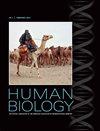Open-Source Tools for Dense Facial Tissue Depth Mapping of Computed Tomography Models
4区 生物学
Q2 Medicine
引用次数: 5
Abstract
abstract:Computed tomography (CT) scans provide anthropologists with a resource to generate three-dimensional (3D) digital skeletal material to expand quantification methods and build more standardized reference collections. The ability to visualize and manipulate the bone and skin of the face simultaneously in a 3D digital environment introduces a new way for forensic facial approximation practitioners to access and study the face. Craniofacial relationships can be quantified with landmarks or with surface-processing software that can quantify the geometric properties of the entire 3D facial surface. This article describes tools for the generation of dense facial tissue depth maps (FTDMs) using deidentified head CT scans of modern Americans from the Cancer Imaging Archive public repository and the open-source program Meshlab. CT scans of 43 females and 63 males from the archive were segmented and converted to 3D skull and face models using Mimics and exported as stereolithography files. All subsequent processing steps were performed in Meshlab. Heads were transformed to a common orientation and coordinate system using the coordinates of nasion, left orbitale, and left and right porion. Dense FTDMs were generated on hollowed, cropped face shells using the Hausdorfff sampling filter. Two new point clouds consisting of the 3D coordinates for both skull and face were colorized on an RGB (red-green-blue) scale from 0.0 (red) to 40.0-mm (blue) depth values and exported as polygon (PLY) file format models with tissue depth values saved in the "vertex quality" field. FTDMs were also split into 1.0-mm increments to facilitate viewing of common depths across all faces. In total, 112 FTDMs were generated for 106 individuals. Minimum depth values ranged from 1.2 mm to 3.4 mm, indicating a common range of starting depths for most faces regardless of weight, as well as common locations for these values over the nasal bones, lateral orbital margins, and forehead superior to the supraorbital border. Maximum depths were found in the buccal region and neck, excluding the nose. Individuals with multiple scans at visibly diffferent weights presented the greatest diffferences within larger depth areas such as the cheeks and neck, with little to no diffference in the thinnest areas. A few individuals with minimum tissue depths at the lateral orbital margins and thicker tissues over the nasal bones (>3.0 mm) suggested the potential influence of nasal bone morphology on tissue depths. This study produced visual quantitative representations of the face and skull for forensic facial approximation research and practice that can be further analyzed or interacted with using free software. The presented tools can be applied to preexisting CT scans, traditional or cone beam, adult or subadult individuals, with or without landmarks, and regardless of head orientation, for forensic applications as well as for studies of facial variation and facial growth. In contrast with other facial mapping studies, this method produced both skull and face points based on replicable geometric relationships, producing multiple data outputs that are easily readable with software that is openly accessible.计算机断层扫描模型密集面部组织深度映射的开源工具
计算机断层扫描(CT)为人类学家提供了生成三维(3D)数字骨骼材料的资源,以扩展量化方法并建立更标准化的参考馆藏。在3D数字环境中同时可视化和操纵面部骨骼和皮肤的能力为法医面部近似从业者提供了一种访问和研究面部的新方法。颅面关系可以通过地标或表面处理软件进行量化,该软件可以量化整个3D面部表面的几何特性。本文描述了使用来自癌症成像档案公共存储库和开源程序Meshlab的现代美国人的未识别头部CT扫描生成致密面部组织深度图(ftdm)的工具。使用Mimics对43名女性和63名男性的CT扫描进行分割并转换为3D头骨和面部模型,并导出为立体光刻文件。所有后续处理步骤均在Meshlab中完成。利用原子坐标、左轨道坐标和左右分量坐标,将头部转换为共同的方位和坐标系。使用豪斯多夫采样滤波器在中空、裁剪的面壳上生成密集的ftdm。两个新的点云由头骨和面部的3D坐标组成,在RGB(红绿蓝)尺度上从0.0(红色)到40.0 mm(蓝色)的深度值上色,并导出为多边形(PLY)文件格式模型,组织深度值保存在“顶点质量”字段中。ftdm也被分成1.0毫米的增量,以方便观察所有面的共同深度。总共为106个人生成了112个ftdm。最小深度值范围从1.2毫米到3.4毫米,这表明了大多数面部的共同起始深度范围,无论体重如何,以及这些值在鼻骨、外侧眶缘和高于眶上边界的前额上的共同位置。除鼻子外,最大深度在颊区和颈部。在体重明显不同的情况下进行多次扫描的个体,在较深的区域(如脸颊和颈部)表现出最大的差异,在最薄的区域几乎没有差异。少数个体眶外侧缘组织深度最小,鼻骨上组织较厚(>3.0 mm),提示鼻骨形态对组织深度的潜在影响。这项研究为法医面部近似研究和实践提供了面部和头骨的视觉定量表示,可以进一步分析或使用免费软件进行交互。所提出的工具可以应用于预先存在的CT扫描,传统或锥束,成人或亚成人个体,有或没有地标,不考虑头部方向,用于法医应用以及面部变化和面部生长的研究。与其他面部测绘研究相比,该方法基于可复制的几何关系生成头骨和面部点,产生多种数据输出,这些数据输出易于使用开放访问的软件读取。
本文章由计算机程序翻译,如有差异,请以英文原文为准。
求助全文
约1分钟内获得全文
求助全文
来源期刊

Human Biology
生物-生物学
CiteScore
1.90
自引率
0.00%
发文量
88
审稿时长
>12 weeks
期刊介绍:
Human Biology publishes original scientific articles, brief communications, letters to the editor, and review articles on the general topic of biological anthropology. Our main focus is understanding human biological variation and human evolution through a broad range of approaches.
We encourage investigators to submit any study on human biological diversity presented from an evolutionary or adaptive perspective. Priority will be given to interdisciplinary studies that seek to better explain the interaction between cultural processes and biological processes in our evolution. Methodological papers are also encouraged. Any computational approach intended to summarize cultural variation is encouraged. Studies that are essentially descriptive or concern only a limited geographic area are acceptable only when they have a wider relevance to understanding human biological variation.
Manuscripts may cover any of the following disciplines, once the anthropological focus is apparent: human population genetics, evolutionary and genetic demography, quantitative genetics, evolutionary biology, ancient DNA studies, biological diversity interpreted in terms of adaptation (biometry, physical anthropology), and interdisciplinary research linking biological and cultural diversity (inferred from linguistic variability, ethnological diversity, archaeological evidence, etc.).
 求助内容:
求助内容: 应助结果提醒方式:
应助结果提醒方式:


